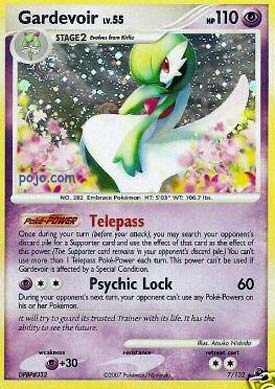|
|
||||||||||||
| Pojo's Pokemon news, tips, strategies and more! | ||||||||||||
|
|
||||||||||||
 |
||||||||||||
|
|
||||||||||||
|
Pokemon Home
Magic
|
2007-08: Season of GardevoirGardevoir was, as mentioned above, released in November 2007. Thus, the first competitive tournaments that the deck would see play in were the City Championships in winter. 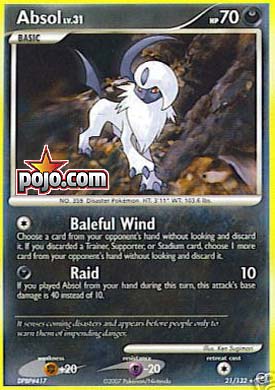 The very first variants of the deck were vanilla Gardevoir/Gallade and a version that added Absol SW to the mix, aiming for extra disruption with Absol's Baleful Wind. In a metagame of Blissey variants, Magmortar/Typhlosion, Feraligatr and Honchkrow/Absol, Gardelade proved its dominance in its very first tournaments, taking over 75 1st Places (Blissey variants were the second winningest, with a mere 19 wins). Gardevoir had hit the scene, and with some aplomb.
The very first variants of the deck were vanilla Gardevoir/Gallade and a version that added Absol SW to the mix, aiming for extra disruption with Absol's Baleful Wind. In a metagame of Blissey variants, Magmortar/Typhlosion, Feraligatr and Honchkrow/Absol, Gardelade proved its dominance in its very first tournaments, taking over 75 1st Places (Blissey variants were the second winningest, with a mere 19 wins). Gardevoir had hit the scene, and with some aplomb.States (S/P/Ts) saw the first true Psychic Lock Gardevoir variants -- Florida calling the version "Plox," much to the vexation of some -- hit the metagame. These Gardevoir lists were more focused than the Cities variants, with consistency and an early Psychic Lock (which would be kept up until the end of the game) being the main goal. The main tech for the S/P/Ts was Blastoise d, for the mirror match-up and handling Gardevoir counters (Psychic types that threatened a quick knockout, such as Banette SW), with its Shield Veil Poké-Body getting rid of Gardevoir's dangerous +30 Psychic weakness.  For consistency, even though Claydol GE -- the draw engine of almost every single deck in the past three formats -- had already been released, most Gardevoir variants went with Furret SW. Despite being a Stage 1, its costless Keen Eye attack warranted its inclusion: Searching your deck for any two cards and putting them in your hand. In the mirror match-up, Furret also allowed you to set up under power lock, with Keen Eye not being affected by an early Psychic Lock.
For consistency, even though Claydol GE -- the draw engine of almost every single deck in the past three formats -- had already been released, most Gardevoir variants went with Furret SW. Despite being a Stage 1, its costless Keen Eye attack warranted its inclusion: Searching your deck for any two cards and putting them in your hand. In the mirror match-up, Furret also allowed you to set up under power lock, with Keen Eye not being affected by an early Psychic Lock.Pachirisu GE, Rare Candy, Celio's Network, and Double Rainbow Energy were maxed in almost all builds for consistency, along with 2-3 Steven's Advice. 3-4 Team Galactic's Wager would ensure a stronger lock. 6 Psychic Energy, 3 Scramble Energy, and 4 DRE would be the default Energy line, along with a few Fighting Energies in most builds. A tech utilized during the S/P/Ts was Feraligatr MT. Despite the apparent lack of synergy, the idea behind it was to counter the popular Magmortar. It was soon abandoned afterward, although its impact would last: the 1/0/1 Feraligatr line would be the first of many 1/0/1 Stage 2 Techs that appeared in Gardevoir lists over the seasons, such as Dusknoir DP and Nidoqueen RI. By Regionals, Gardevoir was undisputably the best deck in the format, and it became a matter of whether play or counter Gardevoir. Magmortar was heavily diminished, and Banette started seeing heavy play by players who didn't want to play such a dominant deck. 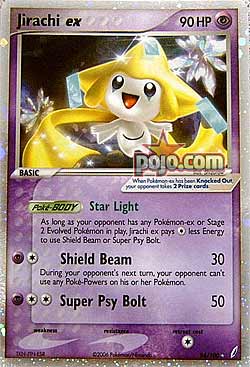 Regionals saw the introduction of Dusknoir DP and Claydol GE into Gardevoir variants, virtually all emphasizing an early and consistent Power Lock. Pachirisu was cut to 3 in some builds, for the inclusion of Tauros CG -- which featured an inferior 2-Basic Call For Family attack, but had a Pokémon Power that discarded the Stadium in play, to get rid of the troublesome Crystal Beach that started seeing heavy play.
Regionals saw the introduction of Dusknoir DP and Claydol GE into Gardevoir variants, virtually all emphasizing an early and consistent Power Lock. Pachirisu was cut to 3 in some builds, for the inclusion of Tauros CG -- which featured an inferior 2-Basic Call For Family attack, but had a Pokémon Power that discarded the Stadium in play, to get rid of the troublesome Crystal Beach that started seeing heavy play.Eric Craig won Florida Regionals -- one of the toughest metagames in the US -- with a Jirachi ex in his Gardevoir list, a future inclusion in almost every single Gardevoir list later in the year. Jirachi ex's Shield Beam was effectively a cheaper Psychic Lock, allowing Gardevoir to set up the power lock even earlier and more consistently. Its Psychic type and lack of weakness made it amazing in the mirror match-up, which were based not on getting Gallades to one-shot the opposing Gardevoirs, but building as many Gardevoirs as possible, and keeping up the Psychic Lock. Giving your opponent a turn in the mirror was a huge liability, and Gallade was thus reserved for other match-ups, with the mirror based on Psychic Locks and Shield Beams. Past Regionals, Magmortar was dead, and Gardevoir was unrivaled. The arrival of Majestic Dawn had intrigued many, with Leafeon Lv.X and Glaceon Lv.X leading to talks of a new Eeveelutions archetype. However, it would be Empoleon MD that would ultimately become an archetype. For Gardevoir, Majestic Dawn offered consistency, in the form of Call Energy. While Pachirisu's Call for Family and Smash Short were highly effective attacks, attaching an Energy on Pachirisu would mean a later Psychic Lock. With Call Energy, starting with a Ralts and a Call Energy threatened a Turn 2 Psychic Lock or Psychic Cut, thanks to Double Rainbow Energy. In Nationals, Gardevoir was intensely dominant. Empoleon MD, while having the ability to increasingly build damage on multiple targets with Dual Splash and get multiple knock-outs, simply could not beat Gardevoir in 30 minute rounds. The rogue Blissey/Banette (endearingly called "Sausage") got as far as 12th Place (Jimmy Ballard), Colin Moll's Torterra even made Top 4, but the rest of the cut was dominated by Gardevoir. 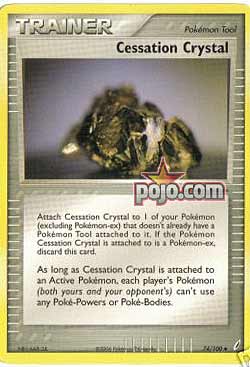 Nationals saw a new variant of Gardevoir, utilizing Cessation Crystal, which allowed the deck to attack with Gallade, while still keeping a lock. The downside of this would be locking your own Powers, leaving you crippled as well. Despite this, the deck was successful: Mikey Fouchet got 3rd Place in Masters with such a build. Nationals saw a new variant of Gardevoir, utilizing Cessation Crystal, which allowed the deck to attack with Gallade, while still keeping a lock. The downside of this would be locking your own Powers, leaving you crippled as well. Despite this, the deck was successful: Mikey Fouchet got 3rd Place in Masters with such a build.The winner was Gino Lombardi, who got 2nd to Eric Craig in Florida Regionals. His Gardevoir build was focused on the mirror, with a tech Breloom SW. Breloom SW's Homing Uppercut, doing 120 damage to any Pokémon with no Retreat Cost, comboed with both Phoebe's Stadium and Moonlight Stadium, both of which would give Gardevoir free Retreat. Then came Worlds. Due to Gardevoir's stranglehold on the metagame, PUI enacted a measure that would extend rounds to 40 minutes. Gardevoir, which never needed to pick up 6 Prizes, but could simply keep up a strong lock all game and win by a prize or two, was the clear target of this round limit increase. 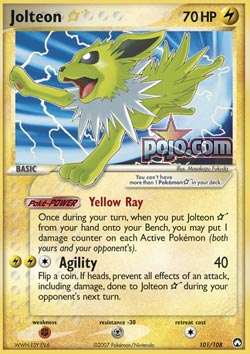 Not only was Gardevoir hurt by this the longer rounds, they also benefitted Gardevoir's main rival: Empoleon/Bronzong. Empoleon could now spread more damage, and Gardevoir simply could not deal with an early Dual Splash, which would quickly add up to multiple knock-outs. Bronzong MD could survive a Psychic Lock, and keep the spread going. Overall, Empoleon/Bronzong would finally be a deck that could not just keep up with Gardevoir, but beat it.
Not only was Gardevoir hurt by this the longer rounds, they also benefitted Gardevoir's main rival: Empoleon/Bronzong. Empoleon could now spread more damage, and Gardevoir simply could not deal with an early Dual Splash, which would quickly add up to multiple knock-outs. Bronzong MD could survive a Psychic Lock, and keep the spread going. Overall, Empoleon/Bronzong would finally be a deck that could not just keep up with Gardevoir, but beat it.However, despite Alex Brosseau going undefeated in both the Grinder and the Swiss rounds with Empoleon/Bronzong, he'd lose in Top 32, John Silvestro would lose to Jason himself in Top 16, and Jimmy O'Brien would Top 4 with the deck. Empoleon/Bronzong, despite being equal to or better than Gardevoir, would not even make it to the final. "Meatloaf" (Leafeon Lv.X/Magmortar SW), a rogue played by several players, would bomb horribly. Blissey variants would turn out to do well, due to Gardevoirs focusing more on mirror rather than defend against Cessation Crystal and Crystal Beach. Ultimately, the winner would be Jason "Ness" Klaczynski, who'd become the first two-time World Champion, with Gardevoir. I'm not going to go into detail about his build, as you can read his excellent report on Pojo. Overall, his build would combine consistency with defense against Gardevoir counters, and have the upper hand in mirror, covering all his bases and earning him a World Championship. 2008-09: End of Gardevoir?After Worlds 2008, it was assumed that Gardevoir would be done. After all, it would lose DRE and Scramble Energy to the rotation, alongside Jirachi ex, Celio's Network, Steven's Advice, and various other cards. 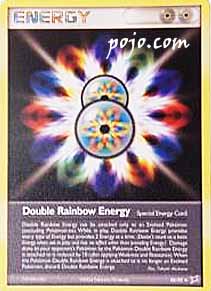 More importantly, the new Legends Awakened would bring forth a power creep. While Psychic Lock was never about the damage, Gardevoir's 60 damage for three Energy went from reasonable to awful with the loss of DRE/Scramble and the introduction of a new breed of attacks, where 40-60 damage for a single Energy became commonplace. Kingdra LA would be the harbinger of this fast damage, and for the Autumn BRs, Gardevoir was let go of.
More importantly, the new Legends Awakened would bring forth a power creep. While Psychic Lock was never about the damage, Gardevoir's 60 damage for three Energy went from reasonable to awful with the loss of DRE/Scramble and the introduction of a new breed of attacks, where 40-60 damage for a single Energy became commonplace. Kingdra LA would be the harbinger of this fast damage, and for the Autumn BRs, Gardevoir was let go of.After the release of Stormfront, Gardevoir's death seemed even more certain: there were many new archetypes, including Dusknoir, which would hit Gardevoir for its Weakness, while remaining safe from a return KO by its Weakness to Dark, rather than Psychic. Despite all this, a new variant of Gardevoir took hold: Gardevoir/Gallade/Weavile, GGW for short. Using Weavile SW for both energy acceleration and damage increase and Poké Healer + to heal, this new variant tried to keep up a lock like the previous season, with the added benefit of an 80 damage Psychic Lock (using Weavile's Darkness Engage), rather than the rather low default of 60. It won a few Cities, but was nowhere near as dominant as it was the previous season's Cities. Then came Platinum, and S/P/Ts. Platinum brought forth the SP mechanic, and S/P/Ts were dominated by Dialga G, Palkia G, and Toxicroak G. However, Gardevoir/AMU managed to win in Utah, the solitary States win for Gardevoir. Regionals saw SP decks, Machamp, and Gengar win. Florida Regionals was once again won by Gardevoir, the GGW/Healer variant winning out in a field of SP and Gengar.  The release of Rising Rivals gave Gardevoir a new Stage 2 Tech: Nidoqueen RI. Gardevoir could now heal even more damage, and Nidoqueen RI would double up as an attacker, being able to dish out a massive 40 for P, and even more with its second attack. In addition to Nidoqueen, Upper Energy provided Gardevoir with some much needed energy acceleration: although Weavile was fast enough, being forced to run Darks would make it harder to be consistent. Gardevoir regularly played from behind, and Upper Energy would fuel Gardevoir, Gallade, and Nidoqueen alike.
The release of Rising Rivals gave Gardevoir a new Stage 2 Tech: Nidoqueen RI. Gardevoir could now heal even more damage, and Nidoqueen RI would double up as an attacker, being able to dish out a massive 40 for P, and even more with its second attack. In addition to Nidoqueen, Upper Energy provided Gardevoir with some much needed energy acceleration: although Weavile was fast enough, being forced to run Darks would make it harder to be consistent. Gardevoir regularly played from behind, and Upper Energy would fuel Gardevoir, Gallade, and Nidoqueen alike.Despite this, Gardevoir was not a huge success at Nationals 2009. SP decks, and the new Flygon, were simply too strong. Gardevoir was good, but firmly in Tier 2. Worlds saw a complete rogue -- former Pojo writer Steven Silvestro's Beedrill/Luxray GL -- win out over a field of Flygon/Machamp and SP decks. Gardevoir, so dominant in 2008, didn't even top 4 at Nationals or Worlds in 2009. 2009-10: End of an EraGardevoir remained a rogue for the first part of the season. Battle Roads and Cities featured various SP decks and Gengar, neither a particularly favorable matchup to Gardevoir. Luxchomp (Luxray GL/Garchomp C) slowly but surely became one of the best decks in the format. Nevertheless, Gardevoir won a few Cities, with the new Spiritomb AR taking the role of Pachirisu GE from 2008 as the starter. 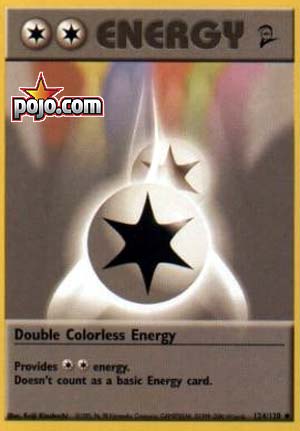 Then, HeartGold & SoulSilver was released. Gardevoir finally received the energy acceleration it had been begging for since August 2008: Double Colorless Energy. Upper Energy was not good enough; DCE would be.
Then, HeartGold & SoulSilver was released. Gardevoir finally received the energy acceleration it had been begging for since August 2008: Double Colorless Energy. Upper Energy was not good enough; DCE would be.Come S/P/Ts, Gardevoir -- now with DCE -- went on to win a few States, while Luxchomp dominated both the top tables and 1st Places. Luxchomp was undisputably the top deck, with Gengar, Gardevoir, Jumpluff and Gyarados battling it out in Tier 2. Regionals -- ran in the same format, with no new set coming out after S/P/Ts -- proved interesting for Gardevoir. Luxchomp remained supreme, but the best record in Regionals went to Michael Pramawat, who went 12-0 with Gardevoir/AMU in Pennsylvania in a field of Luxchomp, Jumpluff, Donphan, and Gyarados. Unleashed, on paper, both helped and hurt Gardevoir: Judge was a better Team Galactic's Wager, depending on your point of view (and RPS skill), but Entei/Raikou Legend could potentially wipe out the board, given Gardevoir's bench being filled with low HP Pokémon with Powers. 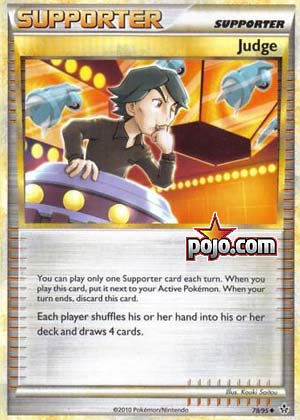 Gardevoir would go on to do well at Nationals, with ERL ending up more powerful on paper than in play. Mikey Fouchet, the highest ranked Gardevoir at the event, would only lose to Kyle Sucevich running Dialga in Top 16, Gardevoir's worst match-up when teching Drifblim FB.
Gardevoir would go on to do well at Nationals, with ERL ending up more powerful on paper than in play. Mikey Fouchet, the highest ranked Gardevoir at the event, would only lose to Kyle Sucevich running Dialga in Top 16, Gardevoir's worst match-up when teching Drifblim FB.There were two major variants of Gardevoir at Nationals: straight Gardevoir, with 3-4 Spiritomb, Claydol and Mewtwo Lv.X/Dusknoir, and Gardevoir/AMU, running no Claydol but featuring an AMU lock and Mesprit Lv.X to unleash heavy damage. Nationals would establish straight Gardevoir with 3 Kirlia, 1-1 Claydol and 1/0/1 Machamp as the best possible variant, with the 3rd Kirlia allowing Gardevoir to get around Gengar's trainer lock and Machamp improving the Dialga/SP/Sableye match-up. Worlds 2010 would be the last competitive tournament where Gardevoir would be legal. Gardevoir went into the tournament a strong contender, with a metagame of SP variants, Gengar, and Gardevoir itself. The final, featuring Luxchomp with Dialga vs Gardevoir, was notable. After all, this was the 2nd Worlds Final that Gardevoir had gotten to. Michael Pramawat, running Gardevoir (with 2 Kirlia), won Game 1, but would go on to lose the next two. Gardevoir, which almost became the first deck to win two World Championships, would fall just short. ConclusionThere we go. Take care, and stop playing Gardevoir -- it's rotated out.  PojoMOTL@gmail.com AIM: PojoMOTL Back to MonsterOfTheLake's Lake Pojo's Pokémon Site |
|||||||||||
|
Copyright© 1998-2009 pojo.com This site is not sponsored, endorsed, or otherwise affiliated with any of the companies or products featured on this site. This is not an Official Site. |
||||||||||||



